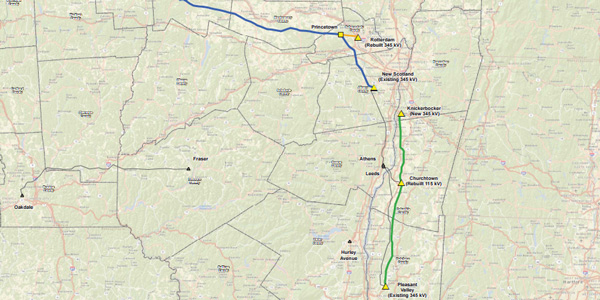By Rich Heidorn Jr.
FERC on Thursday approved NYISO Tariff revisions ordering downstate residents to pay 90% of the cost of AC transmission projects stemming from public policy needs (ER17-1310-001).
The projects, which include the estimated $1 billion Edic-Pleasant Valley 345-kV line and the $246 million Oakdale-Fraser 345-kV line, are intended to relieve downstate congestion by upgrading the AC transmission systems north and west of New York City.
The cost allocation was proposed by the ISO at the direction of the New York Public Service Commission, which said 75% of the costs should be allocated solely to the downstate load zones that will benefit from the congestion relief, with the remaining 25% allocated regionally based on load-share ratio. “According to the New York commission, this method will allocate approximately 90% of the transmission project’s cost to ratepayers in the downstate region, and about 10% to upstate ratepayers,” FERC said.
FERC rejected a protest by four State Assembly members, who said the regional allocation of 25% was too low to account for “some of the financial and societal benefits to ratepayers statewide.”
The commission said the proposed allocation satisfies Order 1000’s requirement that it be “roughly commensurate” with the benefits that the load zones receive, citing a study published by the PSC that found 89.5% of the costs should be allocated to the downstate load zones.
However, the commission added that the ISO’s filing “does not prevent the selected transmission developer from submitting its own proposed cost allocation method for the AC transmission upgrades. The Tariff specifically provides that the selected transmission developer may also file, for the commission’s approval, an alternate cost allocation method or request that NYISO use the default cost allocation method (i.e., load-share ratio).”
ROE Settlement
In a related order, the commission approved a settlement with New York Transco — affiliates of the New York Transmission Owners, Consolidated Edison of New York, National Grid, Iberdrola USA and Central Hudson Gas & Electric — to decide questions regarding their potential compensation for the projects (ER15-572).
The commission had set the matter for hearing in April 2015. (See Divided FERC Trims ROE on NY Tx Projects, Orders Hearing.)
The settlement, which will apply only if NY Transco is selected as the developer, includes a 9.65% base return on equity and a 100-basis-point adder that will apply up to the cost cap, which was defined as the capital cost bid plus an 18% contingency and an inflation factor of 2% per year.
The commission said the settlement, which was unopposed and endorsed by both the New York PSC and FERC staff, “appears to be fair and reasonable and in the public interest.”
Cost Containment
FERC did not rule on state regulators’ proposed cost-containment mechanism, under which ratepayers would be responsible for 80% of any overruns above the estimated cost of the project and retain 80% of any savings.
The commission said it couldn’t rule because the ISO had provided only a description of the risk-sharing proposal without Tariff language. “As such, [the mechanism] is not properly before us,” the commission said. “NYISO states that it plans to file Tariff sheets for the 80/20 risk-sharing mechanism after concluding its stakeholder process.
“In regard to implementing the 80/20 risk-sharing mechanism, because the New York commission recognizes that [FERC’s] policy on cost recovery allows transmission developers to recover costs that are prudently incurred, it proposes to limit the selected transmission developer’s ability to recover costs associated with cost overruns by reducing the allowed return on equity for the transmission project,” FERC added.
Selection Process
NYISO received 16 proposed projects from six developers in response to a February 2016 solicitation for solutions to address the transmission congestion. In a January order, the PSC told the ISO it “should proceed to a full evaluation and selection, as appropriate, of the more efficient or cost-effective transmission solution to meet the” public policy transmission need.
NYISO spokesman Michael Jamison said the ISO hopes to release draft results of its analysis by the end of the first quarter of 2018. “Subsequent to that, the NYISO will select the more efficient or cost-effective project. At that time the NYISO will work out a developer agreement with the chosen party, and that party can initiate actions with the state under the Article 7 transmission siting process.”




